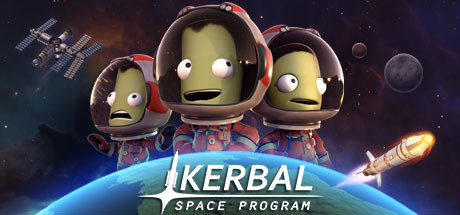Trailer:
Kerbal Space Program is space flight simulator .”Kerbal” comes from the name Felipe “HarvesteR” Falanghe,one of the software programmers, gave small figurines he installed in modified fireworks as a teenager.HarvesteR was hired by Monkey Squad in 2010 April; the company did not develop software at the time.Development of Kerbal Space Program was authorized by Squad co-founder Adrian Goya in 2010 October, but deferred until HarvesteR could be released from marketing set projects in progress.Kerbal Space Program first compiled on 2011 January 17.
The game has large support for game mods and a large community to create them, which developed shortly after the game’s initial release.Notable members of the space industry have taken an interest in the game, such as NASA and Elon Musk of SpaceX. In the game, players control a space program, build and fly spacecraft under physics simulation, and explore celestial bodies.
The player controls a nascent space program operated by Kerbals, a race of small green humanoids, who have constructed a fully furnished and functional spaceport (known as the Kerbal Space Center, or KSC) on their homeworld Kerbin, similar to Earth. Despite being shown as funny cartoon-like little green men, sometimes lacking common sense,[10] they have shown themselves to be able to construct very well-made spacecraft parts and perform experiments.Gameplay consists of constructing rockets and spaceplanes out of a provided set of components and launching them from the in-game space center’s launch pad or runway, then going on to complete their desired mission while averting catastrophic failure, such as running out of fuel or electricity, or the spacecraft breaking apart due to structural problems, otherwise being unable to succeed.
MODS
The game can be played in three different gamemodes that are selected when the player starts a new game: sandbox mode, science mode, and career mode.[16] In sandbox mode, players are free to attempt any mission for which they can construct a suitable vehicle, with no punishments for failure[17] (except the temporary death of Kerbals who died during a mission) and using entirely user-assigned missions. Many players have constructed unrealistic spacecrafts in this gamemode, such as huge rockets, authentic replicas of real-life rockets and aircraft, automobiles, trains and boats.
In Science mode, the initial selection of parts is limited, with the more advanced parts unlocked via “Science”,[16] in the Research and Development building, gained by performing various scientific experiments on Kerbin and throughout the solar system. Science mode was partially designed to ease new players into the game and prevent them getting overwhelmed.[18] Science gained on a mission needs to be received by the space port.[19] This can be done by transmissions via antennas[16] in the game, or recovery by a craft landing back on Kerbin.
Career mode is an extension upon science mode, adding funds, reputation, and contracts. In order to build and launch new rockets, the players must complete contracts to earn funds to pay for the new parts. Reputation will affect how many contracts are given to the player in a future update (less reputation leads to fewer and lower-quality contracts).At the start of career mode, you’re extremely limited in what you can build. The available solid-fuel booster won’t get you far, and so you need to conduct experiments to unlock better equipment. A crew report will generate science, as will observing a vial of mysterious goo, or taking an EVA report on various biomes. It can be a bit of a grind, as you’re encouraged to spend slightly too long repeating experiments in order to progress through to proper space exploration.
PHYSICS
While the game is not a perfect simulation of reality, it has been praised for its representation of orbital mechanics. Every object in the game except the celestial bodies themselves are under the control of a Newtonian dynamics simulation. Rocket thrust is applied accurately to a vehicle’s frame based on the positions in which the force-generating elements are mounted. The strength of the joints connecting parts together is finite and vehicles can be torn apart by excessive or inappropriately directed forces.However,Kerbal does a few favors in his own benefit, for example, planets themselves are grouped much closer together in the game then they are in reality.In a more serious game, the mistakes and failures would feel tragic, or worse, purely theoretical. The Kerbals bring much needed heart to the simulation, and also an element of slapstick. You feel bad when one dies, but not too bad. There’s a consequence to the worst failures, but not a tangible punishment. KSP wants you to learn from doing, and the sacrifices along the way are emotional beats that make success more worthwhile.
As a simulation, it would be easy for Kerbal Space Program to feel cold and dry—like a game designed for an audience of tweed wearing, bushy eyebrow sporting physics professors. That it isn’t is all down to the presentation, and the nature of the Kerbals themselves. They’re clumsy, bumbling tinkerers—rated in-game for their courage and stupidity. It’s the Kerbals that bring physics down to the layman’s level. They’re what stops KSP being about formulas and equations, and make it instead about slapdash engineering. In the context of Kerbal mission control, it makes sense that my moon lander was crudely bolted to the top of a barely functional ship. It makes sense that there’s a Kerbal stranded in orbit—and that, years later, he’s still wearing a big, shit-eating grin.
Science makes for really good game design, and KSP taps directly into that fact.
- developer:Squad
- publisher:Squad
- date of release:27.april 2015


Your Comment Here